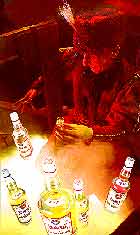| |
|
The
Castle Museum
|
The Devil of Lancut
He visits his old residence seldom, and only at night.
First you hear the hoofbeats on the park lane, and then in the windows of the
castle a red glimmer appears and fades. When the Museum staff notices hoofprints
in front of the gate in the morning, they know that a strong smell of sulphur
will be hanging in the air of the castle chambers . . .
 As
a young boy, Stanislaw Stadnicki was already turned against his neighbors
in his home town of Dubiecko and Sanem, constantly getting into scuffles
and fights. In 1577-1582 he took part in King Stephan Batory's Gdansk
and Moscow campaigns. That is when he began to be called "Devil"
because of the reckless courage which distinguished him from the other
soldiers. Later he fought in Hungary in Emperor Rudolf II's army against
the Turks, and in Archduke Maximilian Hapsburg's units at Byczyna in 1588;
he also took up banditry, attacking noble manors and traders' caravans
near Cracow.
As
a young boy, Stanislaw Stadnicki was already turned against his neighbors
in his home town of Dubiecko and Sanem, constantly getting into scuffles
and fights. In 1577-1582 he took part in King Stephan Batory's Gdansk
and Moscow campaigns. That is when he began to be called "Devil"
because of the reckless courage which distinguished him from the other
soldiers. Later he fought in Hungary in Emperor Rudolf II's army against
the Turks, and in Archduke Maximilian Hapsburg's units at Byczyna in 1588;
he also took up banditry, attacking noble manors and traders' caravans
near Cracow.
He settled for good in Lancut in 1592, and soon thereafter "of Lancut" was added
to "Devil," for he was in constant conflict (or rather, regular warfare) with
the whole region, raiding and plundering his neighbors' residences at the head
of a division of mercenaries numbering 1,500-2,000. He inspired panicky fear
among his subjects; he robbed the townspeople and led the town to ruin. He hid
his loot in a nearby pond. It was also said that he minted false coins in the
castle basements.
In 1608 the combined armies of Stadnicki's neighbours---Governor Lukasz
Opalinski of Lezajsk, and Duchess Anna Ostrogska---took and burned Lancut Castle.
For two more years Stadnicki roamed the area with his remaining mercenaries. On
August 20, 1610, after another skirmish, a Tartar from Opalinski's forces caught
him and cut off his head in a forest near Tarnawa. As a reward, the Tartar was
made a noble, and of Lukasz Opalinski it was long said that he had defeated the
devil and burned down hell in Lancut.